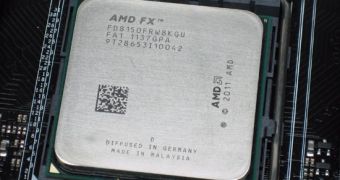Texas-based CPU and GPU designer, fabless company AMD has successfully launched its Trinity mobile processors based on the new Piledriver processing core architecture.
The combination between the Piledriver architecture, the frequency increase and the VLIW4 iGPU made Trinity a tough competition for Intel’s Ivy Bridge.
Intel’s Ivy Bridge has a clear technological manufacturing advantage over AMD’s Trinity. That alone should give it the edge, especially in the mobile market, where the more advanced manufacturing process usually results in less energy consumption.
Ivy Bridge comes with various architecture improvements that make the x86 processing cores significantly more capable than AMD’s x86 units, and it also has a new and improved iGPU architecture running at twice AMD’s iGPU frequency.
Despite all these advances, AMD manages to frequently surpass Intel’s Ivy Bridge in most 3D applications, while maintaining a decent level of performance in non-3D software.
Moreover, being a 32 nm APU, Trinity was expected to achieve lower battery life when compared with the 22nm Ivy Bridge, but that is clearly not the case.
We can’t definitely say that AMD’s Trinity has the definite battery advantage, but it’s clear that AMD’s APU is edging Ivy Bridge in many test scenarios, while surpassing it in others.
We’re still waiting for the desktop versions of AMD’s Trinity, but the company is keen on ensuring a proper supply for the mobile market where Trinity has been so successful, and also on keeping up with the orders from the big OEMs like HP, Acer and others.
While the desktop Trinity is not yet here, many are wondering about the performance of the high-end FX processors that will use the new Piledriver architecture.
We were fortunate enough to get a sneak preview of desktop Piledriver performance from Tom's Hardware’s Chris Angelini.
Mr. Angelini put up a very detailed and well-written desktop Trinity preview that has also compared the Piledriver cores inside Trinity to FX 8150’s Bulldozer cores.
The FX 8150 Bulldozer was overclocked to achieve the same 3.8 GHz frequency Trinity has, and the extra two cores were disabled.
Having the same clock frequency and the same number of FPU and INT units enabled, Trinity managed to get a 15% lead on the FX 8150 in both single-threaded and multi-threaded applications.
It is clear now that the additional 8 MB of level 3 cache has offered Bulldozer an advantage that Trinity doesn’t have.
Despite this advantage, the Piledriver cores inside Trinity managed to achieve this significant 15% performance increase.
We can only conclude that adding 8 MB of level 3 cache can only help Piledrive-based FX 8350 achieve even better performance results.
Therefore, it is safe to assume that the Piledriver-based desktop processors will be at least 20% faster than the Bulldozer-based FX CPUs.

 14 DAY TRIAL //
14 DAY TRIAL //